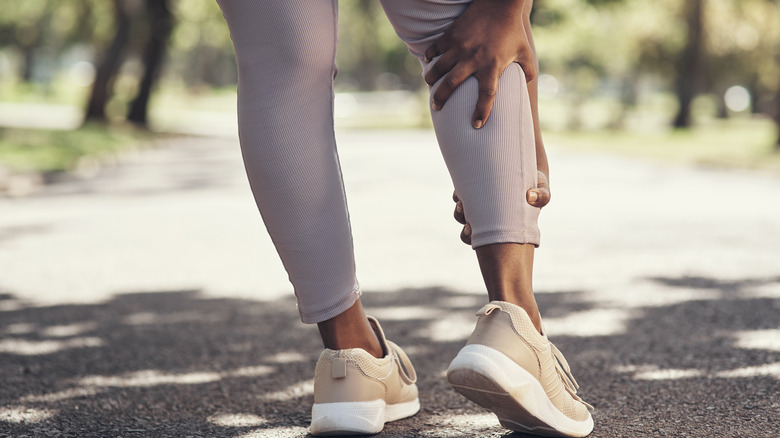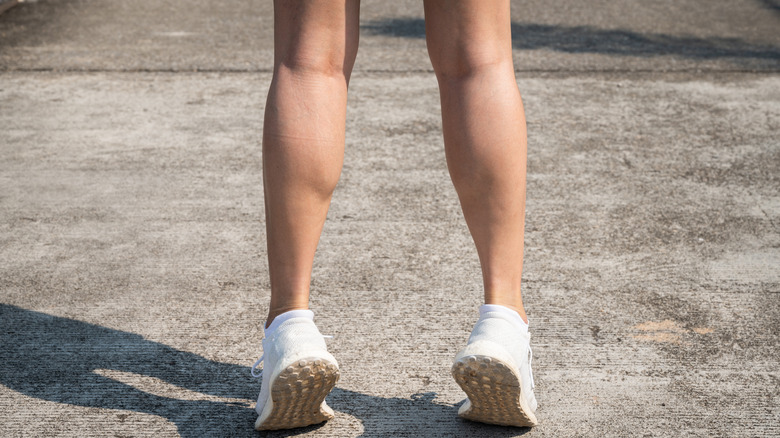Do This Simple Leg Exercise To Improve Your Balance
If you've ever stood on your tippy-toes to reach something high up on a shelf, you may not have realized it, but you just put in some leg reps towards improving your balance. In the eight years between 2008 and 2016, the number of people who reported issues with balance during the last year jumped from approximately 11% to roughly 15.5%, according to a 2023 survey analysis published in OTO Open. Many of these individuals reported related problems, including dizziness, feeling faint, or symptoms of vertigo. For some, this made it difficult to perform everyday activities like working out, driving a car, or descending a flight of stairs.
While some people are formally diagnosed with balance disorders in need of treatment, others may just feel a little wobbly from time to time, such as when trying out a new dance class or being asked to stand on one foot during a game of Simon Says with your niece or nephew. In these cases, some routine balance exercises may help you feel a little more sturdy the next time you attempt a tree pose in yoga class. That tippy-toe move you unconsciously did earlier? That's called a calf raise, and it's an effective and simple place to start.
Try unilateral or bilateral calf raises
Also called a heel raise, the exercise involves lifting yourself up onto the balls of your feet so your heels leave the floor, explains Real Simple. Remain in this position for a few moments before bringing your heels slowly back onto the ground. That's it! While it may not feel very laborious, calf raises give our calf muscles and our ankle joints a much-needed workout, and they can be a great way to cool down and stretch after a full-body sweat session.
If you find yourself teeter-tottering while up on your toes, there are a few different ways you can alter the exercise to make it easier. Perhaps the simplest solution is to try calf raises while seated in a chair. Additionally, slip on some shoes if the bare floor is placing uncomfortable pressure on the bottoms of your feet. You can also try an assisted calf raise, which involves holding onto a wall or piece of furniture while doing the exercise to help keep you steady as you're starting out. For those who want to kick things up a notch, try doing calf raises while squatting, lifting weights, or raising only one foot before switching to the other. This is called a unilateral calf raise. So just how many calf raises should we aim to do?
How many calf raises should you do?
For those lifting two feet off the floor or for those doing assisted calf raises, it's best to begin with three cycles of ten to twelve calf raises for a grand total of 30 to 36 exercises (via Real Simple). For those weightlifting, squatting, or giving unilateral calf raises a go, aim for three cycles of five to eight instead, giving you a total of 15 to 24 calf raises. When making any exercise more strenuous, it's important not to overdo it.
If you're still unsure as to whether such a small exercise can make a difference, consider the results of a 2020 study published in PLOS ONE in which more than 80 seniors underwent a 24-week exercise regimen before taking the Calf-Raise Senior (CRS) test. The exercises focused on elements specific to calf raises, such as muscle strength, flexibility, and balance. Small to moderate improvements in CRS test scores were seen, particularly among those who had lower scores prior to the intervention. The researchers concluded that such exercises may boost functional mobility in older adults.
These results echo earlier findings from a 2017 study published in the Journal of Applied Physiology in which calf-raise training resulted in a minor improvement in the balance of elderly men. While improvement was initially small, the researchers theorized that the gains in muscle strength observed in participants would likely lead to continuous balance improvement in the long run.



